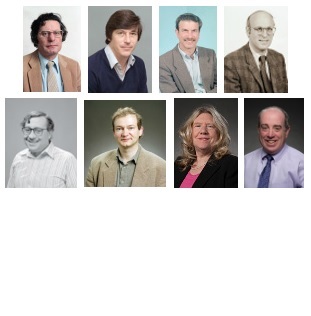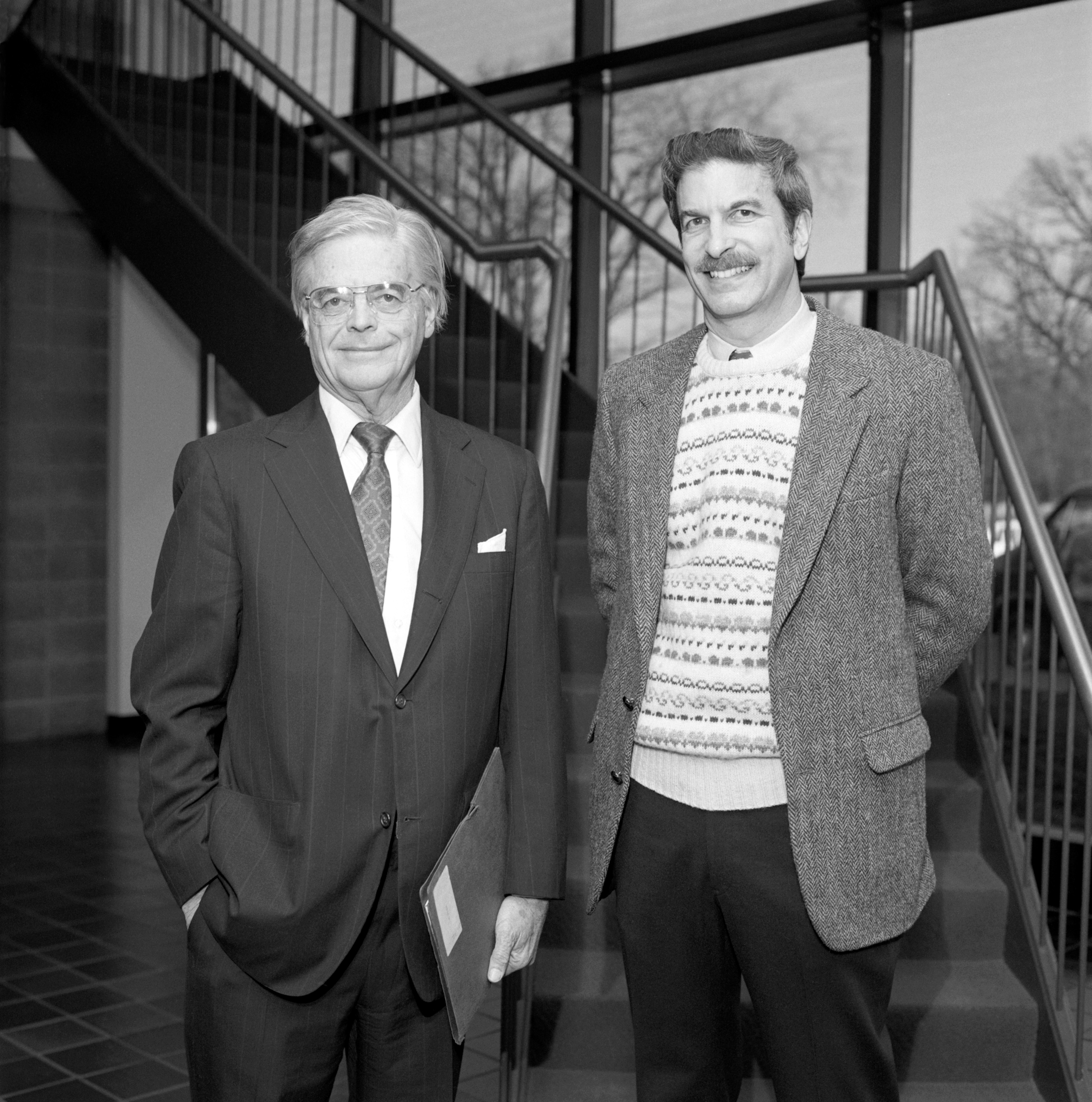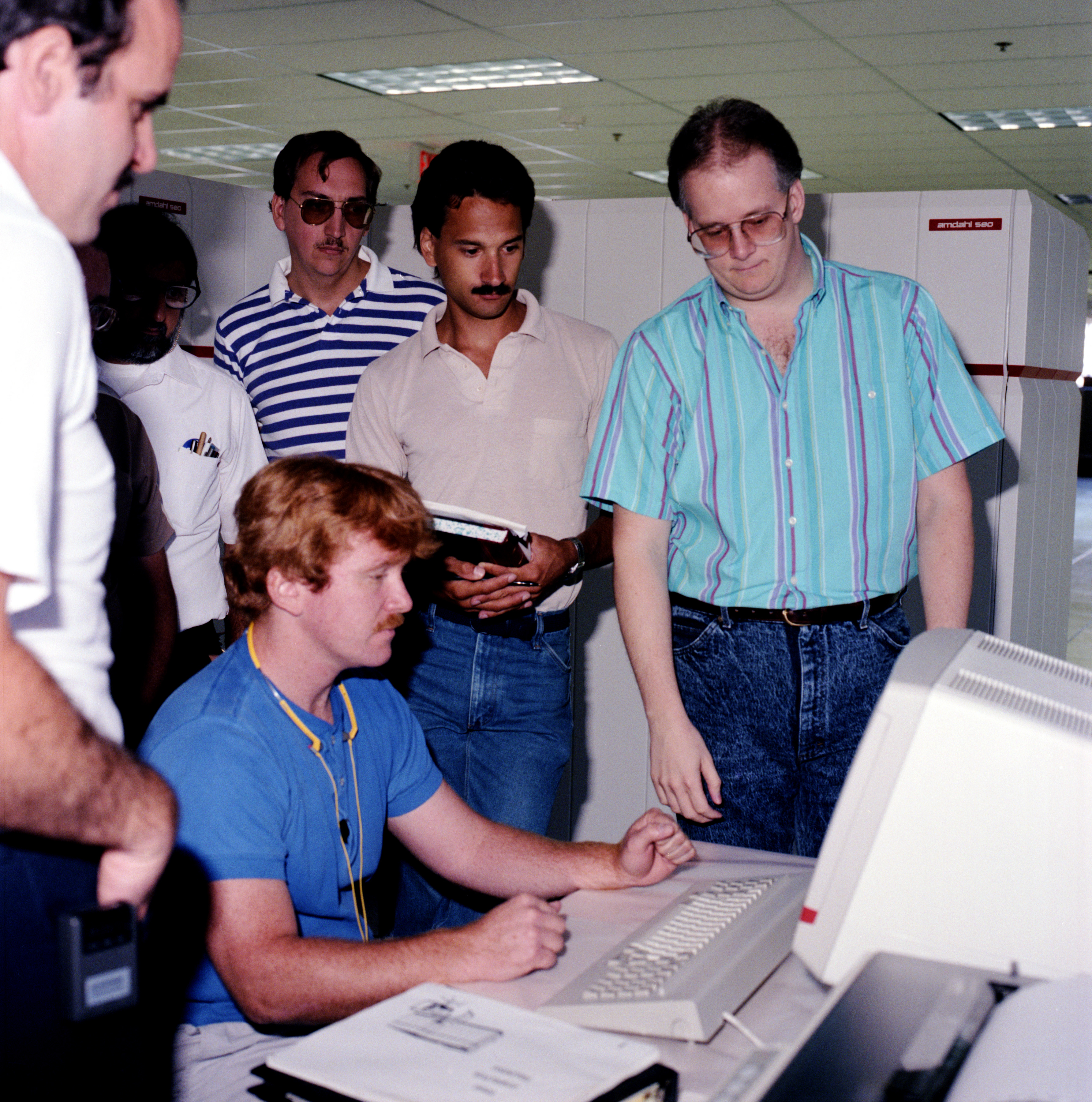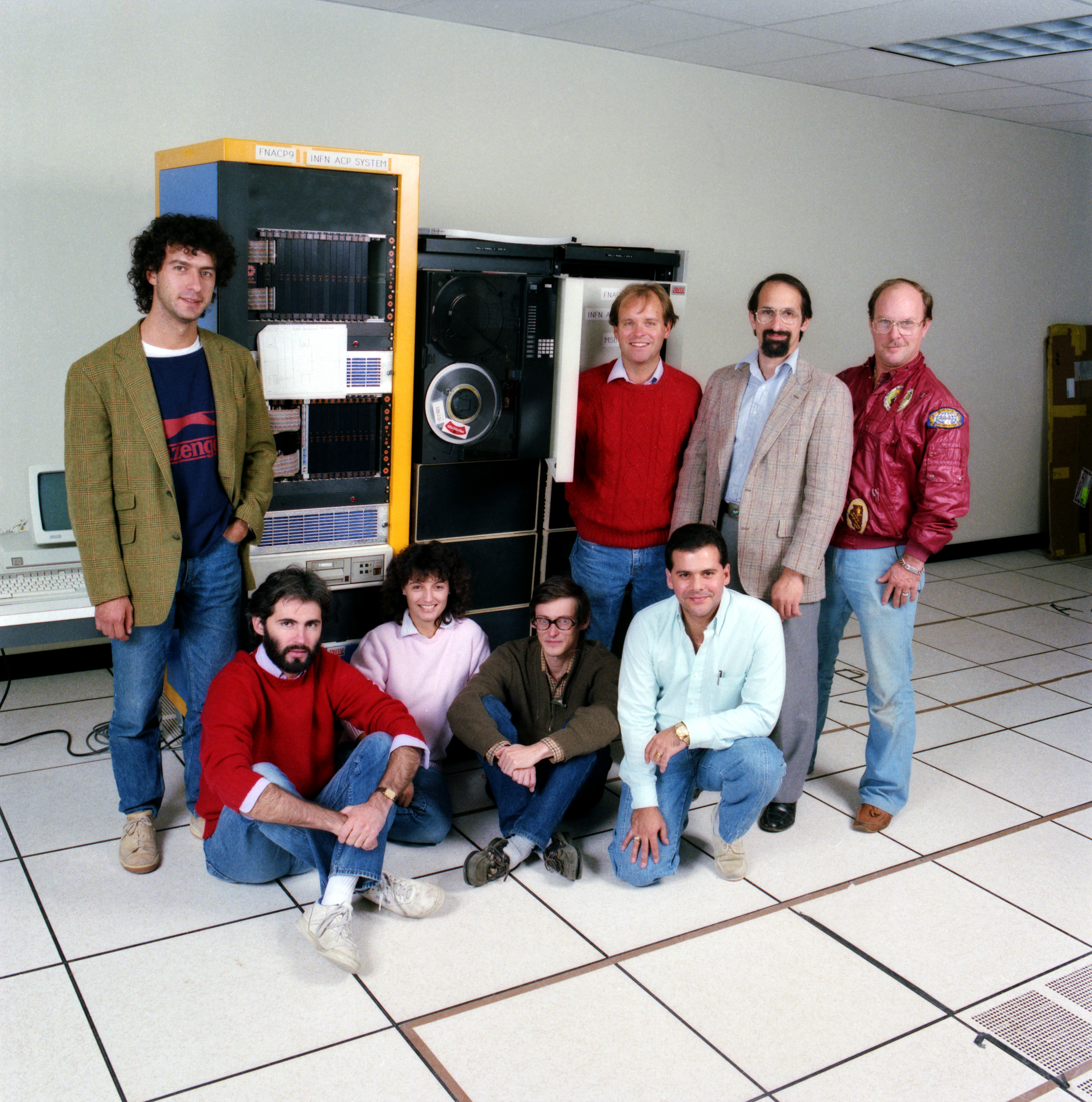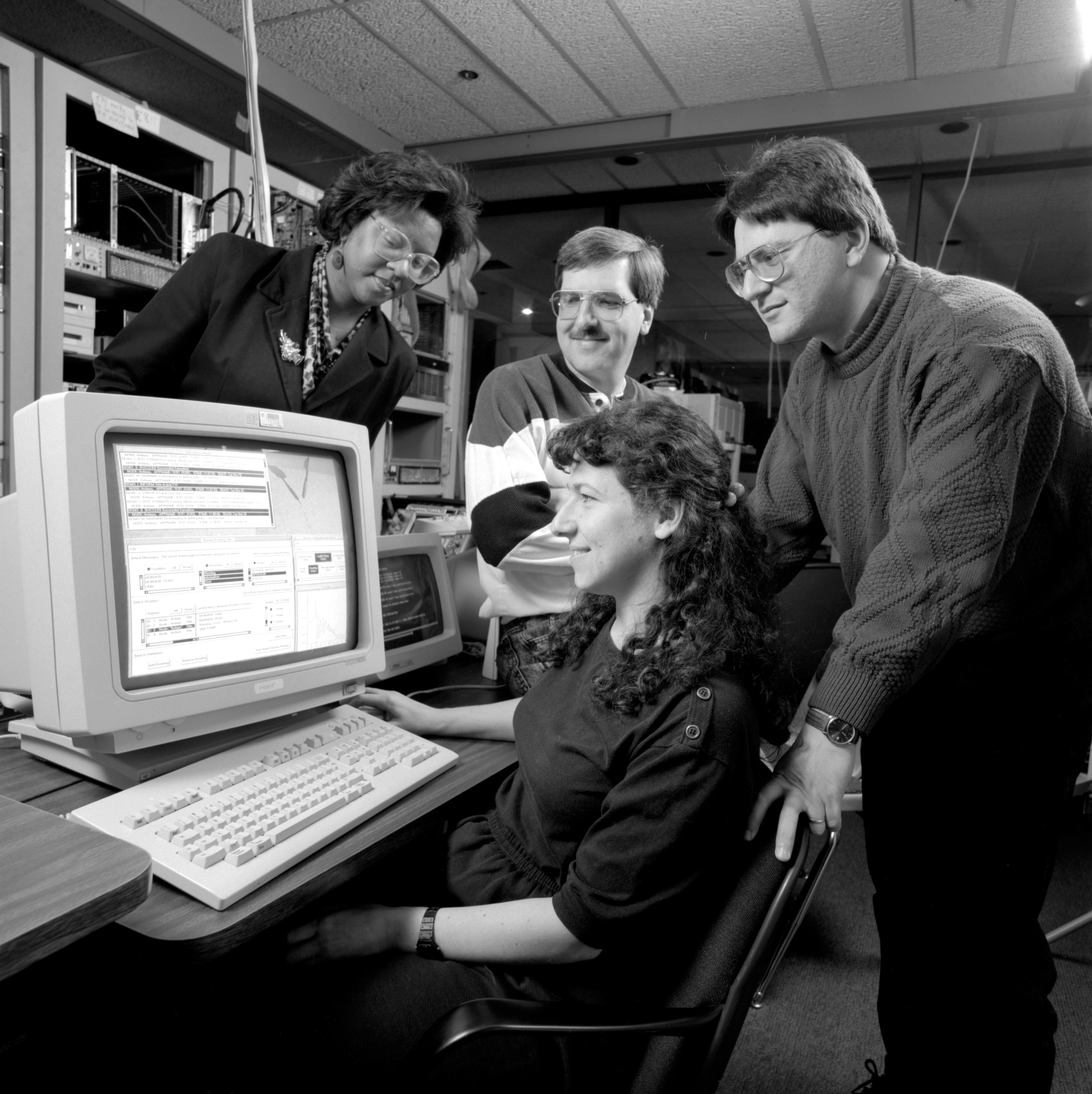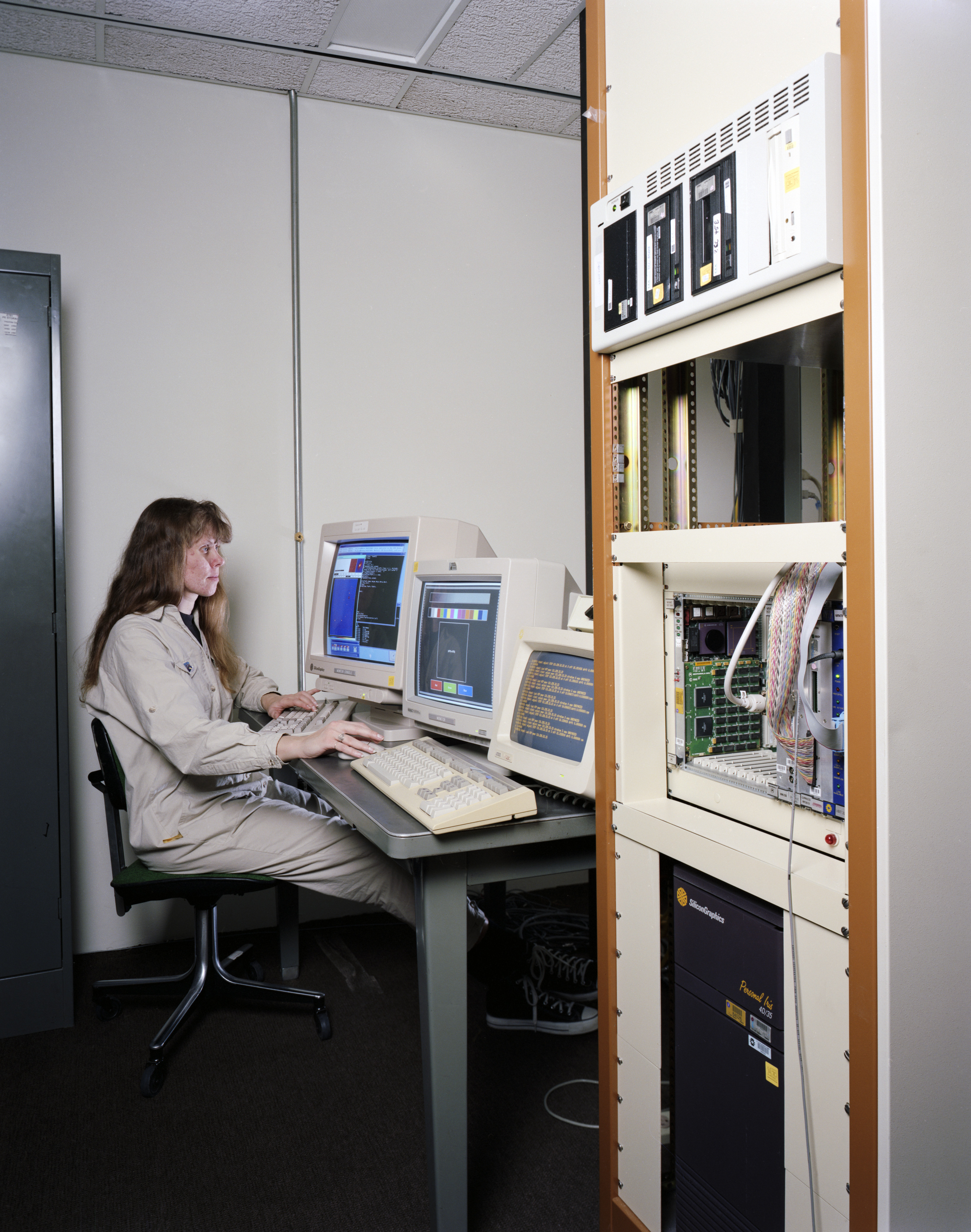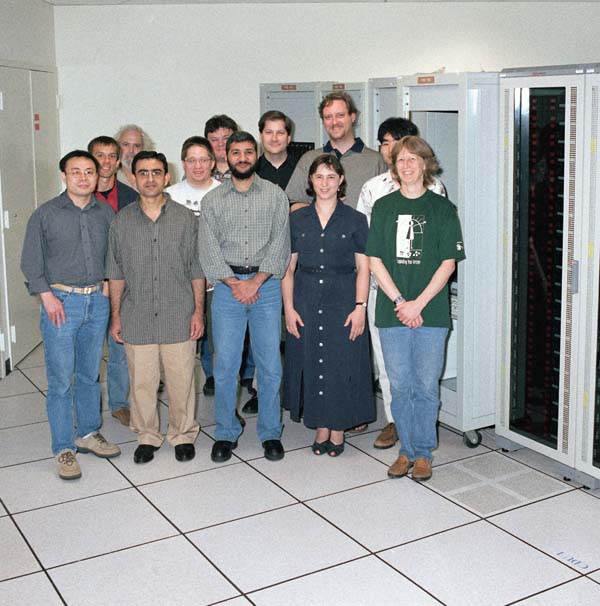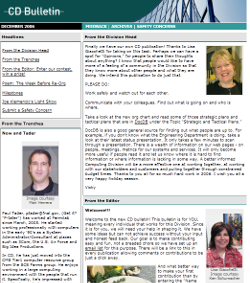Major Computing Milestones
Oct. 1989 - The Computing Department, the Advanced Computer Program and personnel from the research department merge to create the Computing Division headed by Thomas Nash
April 1990 - STK 3480 tape drive, STK = 1.2 TB tape robot
Sept. 1990 - Cyber mainframe computers removed from Wilson Hall through windows
1991 - First 8mm tape used to record data from a particle physics experiment
1991 - Fermilab establishes its first UNIX farm
Jan. 1991 - ACPMAPS Weitek version launches, performs 5 Gflops
May 1992 - Dzero experiment detector observes first proton-antiproton collisions
Sept. 1993 - DART version 1.0 is released
1994 - Joel Butler becomes head of the Computing Division
1994 - First Digital linear (DLT) Tape used (10 GB of storage)
April 1994 - Fermilab's first official website goes live. 12 thousand hits on the first day
Dec. 1994 - LHC approved by CERN
1995 - Amdahl decommissioned
Feb. 1995 - Tevatron sets a world record for number of high-energy proton-antiproton particle collisions
March 1995 - Discovery of the top quark announced by the Collider Detector at Fermilab (CDF) and Dzero
1997 - Sequential Access via Metadata (SAM) project begins
1997 - PC Farms pilot project to show that commodity hardware with a free OS could be used for Farms computing
1997 - US CMS computing project is established
June 1997 - First external review (known as the von Ruden review) of the CDF, D0 CD Joint Run II Offline Computing Project project to design and build computing systems for Run II
1998 - Matthias Kasemann becomes head of the Computing Division
1998 - GRAU/ADIC tape robot, LTO3, 8mm tape DLT
Jan. 1998 - First PC farm with dual 333-MHz Pentium III
March 1998 - Discovery of the B-sub-c meson, the last of the quark-antiquark pairs known to exist, at CDF
June 1998 - Sloan Digital Sky Survey (SDSS) begins operation
July 1998 - Enstore mass data storage project begins in preparation of the Run II experiments
Aug. 1998 - First version of Fermi Linux released
Oct. 1998 - First functioning prototype of Sequential Access via Metadata (SAM)
1999 - SDSS finds a faint red object in its data, later found to be a class T dwarf star
March 1999 - Direct charge parity (CP) violation observed by K-mesons by KTeV experiment
2000 - SDSS finds most distant quasar yet (to that point in time)
July 2000 - DONuT announces the discovery of the tau neutrino
Nov. 2000 - US CMS Software and Computing program begins. Fermilab named CMS tier 1 computing site
Nov. 2000 - First lattice QCD cluster ("qcd80") installed at New Muon Lab; houses the first Linux based tightly-coupled computing center for Lattice QCD computations
March 2001 - Tevatron Run II
March 2001 - D0 starts processing data with SAM for Run II
Aug. 2001 - Fermilab receives $1.28 million of DOE SciDAC awards for work in Lattice Gauge Computing, Open Science Grid and Accelerator Science and Simulation
Nov. 2002 - Vicky White becomes head of the Computing Division
Jan. 2003 - Lattice QCD "w" cluster 1.228 teraflop peak
Nov. 2003 - Grid2003 project begins at SC2003
2004 - Sloan Digital Sky Survey - supernova (SDSS SN) survey born
2004 - Grid Computing Center (GCC) is commissioned and built
2004 - Heavy quark B-sub-d mixing observed by CDF and DZero
May 2004 - Scientific Linux created; now used worldwide
Dec. 2004 - LHC Physics Center (LPC) working groups formed at Fermilab
2005 - Open Science Grid established
2005 – SL8500 Tape LTO3 200GB, 400GB robot
April 2005 - First "core" FermiGrid services deployed
Nov. 2005 - Lattice QCD "pion" 3.329 teraflop peak
Nov. 2005 - SAM deployed by CDF
July 2006 - Lattice Computing Center refurbished with new raised floor, replacement of chiller-based air conditioners with gas-based condensers and overhead cooling units
Sept. 2006 - Lattice QCD "kaon" 9.6 teraflop peak
Sept. 2006 - Observation of B-sub-s meson matter-antimatter oscillations: 3 trillion times per second
Nov. 2006 - CMS Center formed at Fermilab
Dec. 2006 - First issue of online Computing newsletter--what would become CD Tracks and eventually Computing Bits newsletter--published
Oct. 2007 - LHC Remote Operations Center dedicated
Nov. 2007 - Fermilab's booth at SuperComputing 2007 includes a 13-foot tall spiral of Fermilab's computing history
Feb. 2007 - CD reaches five years without a lost workday injury
Feb. 2007 - Job descriptions for Computing Professionals are being reviewed; first time updated since 1991, 1992
April 2007 - Real Time conference hosted at Fermilab
Aug. 2007 - Fnal.gov domain name renewed, celebrates 20th anniversary of its registration
Aug. 2007 - Video series on GCC computer rooms created
Oct. 2007 - Panagiotis Spentzouris named Principal Investigator (PI) of Community Petascale Project for Accelerator Science and Simulation (ComPASS)
May 2008 - The Particle Physics Project Prioritization Panel (P5) publishes its recommendations for the next ten years of particle physics
May 2008 - Fermilab hosts National Laboratories Information Technology Summit (NLIT)
Sept. 2008 - Fermilab hosts the Pixel 2008 International Workshop
Jan. 2009 - Alpha release of the cmslite framework, a C++-based framework that will eventually become art is made; adopted by the Mu2E experiment
2009 - FCC third floor high-availability computing center and computer cooling center constructed
May 2009 - ADIC Tape robot dismantled
2010 - Joint Dark Energy Mission becomes the first user of FermiCloud
March 2010 - Vicky White named Fermilab's chief information officer
April 2010 - The Computing Division celebrates 4 million hours without an accident
Nov. 2010 – FermiCloud turned on after a project to launch it formed in fall 2009
Dec. 2010 - CD Tracks reaches 50th issue
2011 - SharePoint introduced at Fermilab
Jan. 2011 - NOvA adopts art after an effort to evaluate and produce new features
Feb. 2011 - GCC wins first of four thus far Energy Star Awards
April 2011 - New cloud-based Service Desk rolls out
Sept. 2011 - The Computing Division becomes the Computing Sector
Sept. 2011 - Tevatron shuts down after 28 years of operation
Oct. 2011 - Jon Bakken named head of Core Computing Division
Nov. 2011 - Grid and Cloud Computing demonstrate the use of a 100 gigabytes per second network at SC2011
Nov. 2011 - SDSS is listed as "One of the most amazing databases in the world" by Popular Science magazine
Jan. 2012 - Rob Roser introduced as the head of the Scientific Computing Division
Jan. 2012 -The Engineering Data Management System (EDMS) using Teamcenter officially launches
May 2012 - Data Movement and Storage group celebrates 40 PB of data stored
May 2012 - Fermilab celebrates 20th anniversary of website
May 2012 - The first tag (alpha release for demonstration purposes) of artdaq was made
June 2012 - artdaq was presented IEEE Real-time Conference) 2012 as a interesting toolkit and system that included HPC technology for building parts of a DAQ system
July 2012 - Higgs Boson discovery announced by CERN
Sept. 2012 - Dark Energy Survey (DES) starts five years of taking data
Feb. 2013 - Fermilab earns ISO20000 certification for service management best practices
May 2013 - artDAQ first used to take data from the DarkSide-50 time-projection chamber; artdaq-demo, which has sample code to help new and potential artdaq users learn how they can customize it for their experiment, is also released
June 2013 - CERN announces it will use Fermilab developed software Synergia for beam dynamics simulations
Aug. 2013 - DOE awards a three-year grant to the Network Research group for "Multicore-aware Data Transfer Middleware"
Oct. 2013 - Jin Chang becomes Deputy CIO
Oct. 2013 - NOvA processes test data on the Open Science Grid using the Sequential Access Model (SAM) and IFDH
Feb. 2014 - Rob Roser named chief information officer
June 2007 - D0 completes data reprocessing using SAMGrid on OSG
June 2014 - CMSSW released
June 2014 – FermiWorks modernized human resource system launched; joint project involving human resources and computing staff
July 2014 - Muon g-2 magnet arrives at Fermilab
Sept. 2014 - Panagiotis Spentzouris named Scientific Computing Division head
[Note: The original article contained many external links, some no longer current, that are not reproduced here.]
